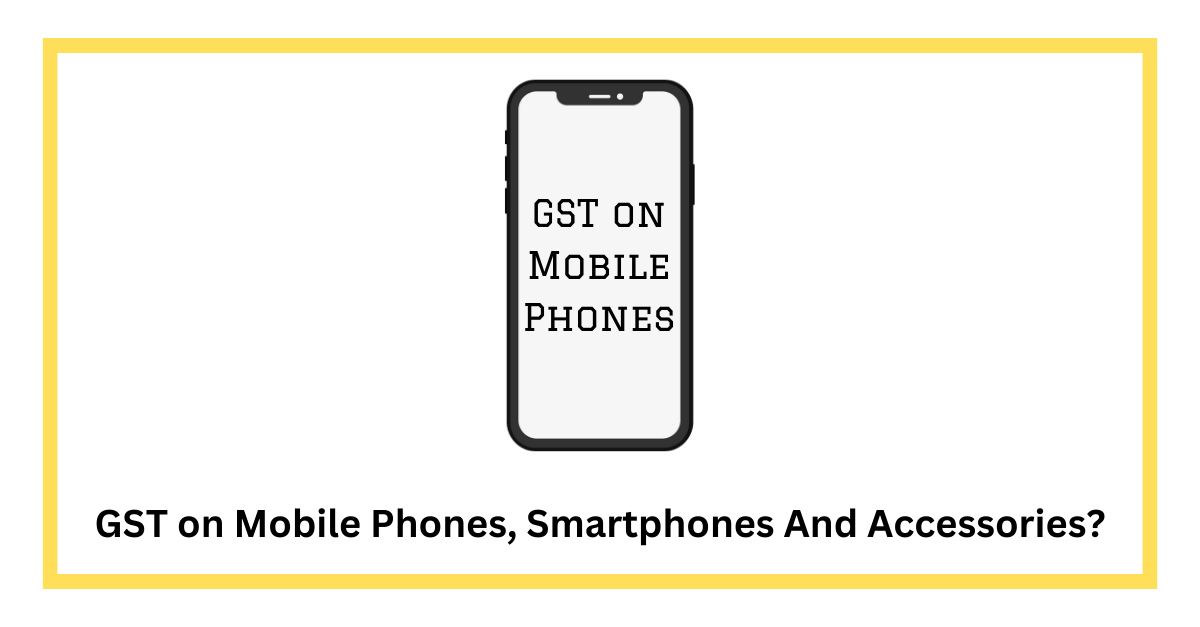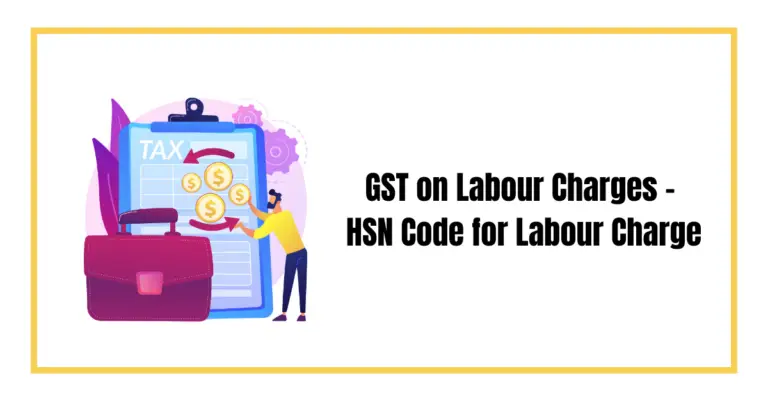At the 39th GST Council meeting, the rate of GST for mobile phones and accessories was increased from 12% to 18%. Mobile phone prices have increased as a result.GST on mobile phones, GST on mobile accessories, and claiming GST on mobile phones as an input tax credit is explained here.
Under the Goods and Services Tax, most commodities sold in India will be subject to one major tax bracket. This would result in lesser calculations and more ease in payment of the tax. Most of the revisions have been readily accepted by members of the public, while some have been heavily criticized. As each revision updates and improves the previous template, the current GST trends remain as the finance department coordinates with the banking institutions to set a reasonable slab. Here is the GST rate for mobile phones and their accessories.
How did the Price on Mobile Phones Change Because of the GST?
Before the implementation of GST in 2017, mobile phones in India were subject to a diverse range of taxes, such as luxury taxes, Value Added Taxes (VATs), and numerous other state-specific taxes. These taxes varied from state to state, causing price discrepancies across regions. The taxation structure was complex, creating challenges for both consumers and manufacturers.
However, with the advent of GST, the taxation system underwent a significant transformation. All the previously existing taxes were merged into one comprehensive tax – the Goods and Services Tax (GST). This streamlined the taxation process, simplifying the overall structure and removing the complexities associated with the previous multi-tax regime.
Currently, the GST on mobile phones falls under the 18%, regardless of whether they are new or used. This uniform tax rate has brought about a level of consistency in mobile phone prices across the country, benefiting consumers and manufacturers alike. The 18% GST rate has also helped in standardising pricing strategies, making it easier for consumers to compare prices and make informed purchasing decisions.
How is GST Beneficial to the Dealers of Smartphones?
GST, or Goods and Services Tax, has proven to be highly beneficial for smartphone dealers across India, transforming the taxation landscape and simplifying their operations. One of the primary advantages of GST for these dealers is the establishment of a uniform tax rate applicable throughout the country. This unity in taxation rates has significantly simplified the calculation of input tax credit and refund claims, minimising the bureaucratic burden and paperwork associated with varying state tax rates.
Furthermore, the introduction of GST has streamlined compliance procedures, enabling smartphone dealers to adhere to tax laws with greater ease and efficiency. This not only saves time but also ensures compliance accuracy. Economically, GST has played a crucial role in cost reduction by eliminating the complications of multiple taxes, including the reduction of transportation costs linked to inter-state transactions.
Moreover, GST has effectively eliminated the cascading effect of multiple taxes, boosting operational efficiency and ultimately enhancing profitability for dealers. These savings and efficiencies allow dealers to offer competitive pricing to consumers, passing on benefits in the form of reduced smartphone prices. Additionally, GST encourages responsible environmental practices by discouraging over-the-counter purchases of cell phone batteries and ensuring their proper and eco-friendly disposal.
Present Scenario
The present-day world has declared smartphones as their primary concern, and with annual sales skyrocketing yearly, the trend is here to stay. Several small and medium-level enterprises sell mobile phones and mobile accessories, and the industry is booming and expecting even more growth in the years to come.
Mobile phones and mobile accessories in India are under Goods and Services Tax. The GST on mobile phones is currently 12%, irrespective of whether the device is a smartphone or a feature phone. The GST rate on mobile electronic accessories is 18%.
Why GST?
Before the GST, VAT was the primary form of tax levied on the mobile phone, and as the VAT rates vary from state to state, it was difficult to fix a standard price for the phone. Under GST, the tax rate is the same across the length and breadth of India. Hence, some much-needed uniformity has seeped into the Indian market. Hence, GST on mobile phones’ current rate stands at 12%, and they follow the HSN code 8517. As mobile phones sell out like hotcakes, the government makes a lot of money through the GST charged. Economists believe that phones will become even cheaper as the GST levels drop.
Goods and Services Tax (GST) is the value-added tax levied on all goods and services we use within the country. We offer a GST rate finder service that lists out the GST rates of all goods and services available in India. This service is also known as the HSN finder.
Inter and Intra State
As consumers, we are eligible to pay 12% GST while purchasing a new phone. When the purchase is made from a dealer who resides and operates within the same state, the GST is split into SGST and CGST equally. Meanwhile, if bought from a foreign or migratory dealer, an IGST at 12% would be applicable, which is also the case in case you import phones from abroad.
HSN Codes
Most phones and mobile accessories come under HSN Chapter 85; several slabs are available for taxes. You must know the right HSN code to file your invoice appropriately. Here’s a look at a few HSN codes for commonly bought and used commodities.
| ITEM | HSN CODE | GST RATE |
| Phones | 8517 | 12% |
| Charger | 8504 | 28% |
| Earphone | 8518 | 18% |
| Battery | 8506 | 28% |
| Power Bank | 8504 | 28% |
| Leather Phone Case & Back Cover | 4202 | 28% |
| Memory Card | 8523 | 18% |
| USB Cable | 8504 | 28% |
| Headphones | 8518 | 18% |
| Plastic Screen Protector | 3919 | 18% |
| Tempered Glass Screen Protector | 3923 | 18% |
| Speakers | 8518 | 18% |
The GST rate is 12%, irrespective of whether it is a smartphone or a feature phone. The GST on mobile accessories is 18% and varies slightly according to the specific product. Since mobile phones use wireless networks, they are part of Chapter 85 of the GST schedule. Here’s a look at the GST slab for the products.
- Phone – 12%
- Parts of the phone – 12%
- Landlines – 18%
- Battery / Power Bank (Lithium-ion) – 18%
- Charger – 18%
- Earphone – 18%
- Memory Card – 18%
- USB Cable – 18%
SGST & CGST or IGST on Mobile Phones
The bill for your new mobile phone might show unfamiliar terms like SGST, CGST, and IGST. These are all part of India’s GST (Goods and Services Tax), but they depend on where you bought the phone. Here’s a breakdown:
- Buying within your state: If you purchased the phone from a local shop, you’ll pay a total GST of 12%. This 12% is divided equally between SGST (State GST) and CGST (Central GST), each appearing at 6% on your bill.
- Buying from another state: Ordered your phone online from a different state? You’ll likely see IGST (Integrated GST) at 12% on the bill. This combines both central and state taxes into a single charge.
- Importing a phone: Bringing a phone in from overseas? You’ll pay IGST at 12% on the import value.
Battery Issue
Indian phone manufacturers had asked the government to change the GST for the lithium-ion batteries and charge a 12% tax on them as they are used to manufacture the phone. Parts used for the telephone have levied a fee of 12% while these batteries were getting charged 28%, and it is this discrepancy led to the plea. However, they also reported that having the SGST, IGST and UGST affects the supply chain. It adds interpretational challenges and makes the viability of low-scale production more difficult.
‘The 12% GST on parts for mobile manufacture covers batteries, which are to be inserted into the mobile. There is no revenue implication on this measure, but it will greatly ease the pain which our manufacturers are subject to,’ argues the Indian Cellular Association while talking to revenue secretary Hasmukh Adhia.
After the plea gained momentum, the government slashed GST rates for around 50 items, including washing machines and mobile accessories. Electric companies have assured clients that they will ensure that the benefits will reach them through lower prices.
For example, Rajeev Bhutani, Senior Vice President of Samsung India, clarified, ‘Samsung is a consumer-centric company. We are happy to extend full benefits, that is, 7.81+ percent of GST rate reduction, to all our consumers. It will fuel the demand for consumer electronics products now and in the ensuing festival season. The decision also helped India’s mobile phone industry by lowering the tax on lithium-ion batteries.
What Is the Validity of the GST Certificate?
The GST certificate, once issued, is valid until it is cancelled, surrendered, or suspended. But the GST certificate granted to taxable individuals has a validity date. Understand the procedure for GST registration and GST returns here.
What are Specified Enterprises as per the Notification?
As per the provisions of the MSME Development Act, 2006, the Specified companies are those that have received goods and services from MSMEs and whose payments have not been made until 45 days. More on Income Tax Return Filing.
What Are the Different Modes of Filing the Return of Income?
You can file the income return either in paper form or even electronically. You may require a digital signature to validate the return forms when filing the returns electronically. Learn more about ISO Certification.
Can Anyone Join ISO?
Businesses or individuals can’t participate in ISO. However, ISO membership is permitted for national standards companies and similar organizations representing standardization. More info on NGO Registration in India.
What are the Different Acts in which an NGO is Registered?
The Societies, Trusts, and profitable NGOs are registered under the Indian Trust Act 1882, the Societies Act 1860, and the Companies Act 1956. More about MSME Registration Online.
Introduction to GST on Mobile Phones
The Goods and Services Tax (GST) is a comprehensive, multi-stage, destination-based tax that was introduced in India on July 1, 2017, consolidating numerous indirect taxes that were previously in existence. Its implementation aimed to create a single, unified Indian market and make tax compliance easier. In the context of mobile phones, GST has streamlined tax structures, making it simpler for manufacturers, sellers, and consumers to understand and comply with tax regulations.
Current GST Rates for Mobile Phones
Initially, the GST rate for mobile phones was set at a different percentage but was later standardized across the country. The government periodically revises these rates based on industry feedback and economic considerations. The Harmonized System of Nomenclature (HSN) code for mobile phones helps in categorizing them under a specific tax bracket, which is essential for tax filing and compliance.
The current GST rate for mobile phones in India is 18%. This applies to both domestically manufactured and imported mobile phones.
It’s important to note that while the overall GST rate is 18%, there are specific components of mobile phones that have different GST rates. For example, chargers and batteries may have a lower GST rate of 5%.
Calculating GST on Mobile Phones
The GST calculation is straightforward, involving a specific formula that applies the GST rate to the base price of the phone. By comparing the prices of mobile phones before and after the implementation of GST, consumers can understand its impact on mobile phone pricing. This comparison often reveals the tax burden shift and its implications on the final retail price.
Identify the price of the mobile phone (excluding GST):
This is the base price of the phone before any taxes are added. It’s usually displayed on the price tag or invoice.
- Use the current GST rate for mobile phones:
As of March 5, 2024, the current GST rate for mobile phones in India is 18%.
- Apply the GST rate to the price:
Multiply the price of the phone by the GST rate (expressed as a decimal).
Formula: GST amount = Price of phone (excluding GST) x GST rate
Example:
Let’s say a mobile phone costs ₹20,000 (excluding GST). To calculate the GST amount:
- GST amount = ₹20,000 x 18/100
- GST amount = ₹3,600
Therefore, the GST on the mobile phone will be ₹3,600.
- Add the GST amount to the price to get the final price:
- Final price = Price of phone (excluding GST) + GST amount
- Final price = ₹20,000 + ₹3,600
- Final price = ₹23,600
GST on Mobile Accessories and Services
Similar to mobile phones, mobile accessories and related services are also subject to GST. The rates vary based on the type of accessory or service provided. The introduction of GST has had a notable impact on the pricing of these accessories, influencing both the cost structure and retail prices.
Mobile Accessories:
- 18% GST: This applies to most electronic mobile accessories, such as chargers, headphones, earphones, power banks, and cases.
- Lower GST Rates: Some mobile accessories might have different GST rates depending on their function or material. For example, watch straps, mobile pouches made of textiles, and screen protectors made of plastic might fall under lower GST slabs.
Mobile Phone Services:
- 18% GST: This applies to most mobile phone services, including:
- Mobile recharge: Topping up your prepaid mobile phone plan.
- Postpaid bill payments: Paying your monthly bill for a postpaid mobile phone plan.
- Value Added Services (VAS): VAS include services like caller tunes, caller identification, data rollover, and content subscriptions.
- 5% GST: This applies to repair and maintenance services for mobile phones.
GST and Mobile Phone Imports
GST has also affected the importation of mobile phones into India. Changes in import duties under the GST regime have had a direct impact on the pricing of imported phones. This adjustment in import duties aims to balance domestic manufacturing and foreign imports, influencing the market dynamics of mobile phones in India.
Claiming Input Tax Credit (ITC) on Mobile Phones
Businesses involved in the mobile phone industry can claim Input Tax Credit (ITC) for the GST paid on their purchases, provided they meet certain eligibility criteria. This provision helps in reducing the cost of doing business, as it allows for the offsetting of GST liabilities with the tax already paid on inputs. Proper documentation and compliance are crucial for claiming ITC.
The Economic Impact of GST on Mobile Phones
The implementation of GST has led to price uniformity across states, eliminating the cascading effect of taxes and ensuring that the tax structure across India is harmonious. This uniformity benefits both dealers and consumers by providing clarity in pricing and reducing tax-induced price discrepancies across different regions. The GST regime has also streamlined the tax structure, making it more transparent and easier to manage for businesses within the mobile phone sector. During the 39th session of the Goods and Services Tax (GST) Council on April 1, 2020, it was decided to elevate the GST rate on mobile phones and their accessories from 12% to 18%. This escalation in the GST rate has led to a surge in the prices of mobile handsets, thereby affecting the taxation landscape of the industry
Conclusion
GST (Goods and Services Tax) aims to bring all commodities in the country under one tax bracket. By implementing this new tax initiative, tax calculations will be simplified, and payments will be easier. In this article, we tried to collect detailed information on how GST applies to electronics, including smartphones and accessories.
FAQs
What is the current GST rate for mobile phones in India 2024)?
The current GST rate for mobile phones in India, both domestically manufactured and imported, is 18%.
How do I calculate the GST on a mobile phone purchase?
GST amount = Price of phone (excluding GST) x 18/100
What is the GST rate for mobile phone repairs and services in India as of 2024)?
Unlike the 18% GST on new phones and most services, mobile phone repair and maintenance services are subject to a lower GST rate of 5%.
Can I claim Input Tax Credit (ITC) on the GST paid on a mobile phone purchase?
Generally, ITC is only available for businesses registered under GST. If you are an individual buying a mobile phone for personal use, you cannot claim ITC on the GST paid.
How has the GST rate on mobile phones changed over time?
The GST rate on mobile phones has been revised once since its implementation in 2017:
- July 1st, 2017: The initial GST rate on mobile phones was 12%.
- April 1st, 2020: The GST rate on mobile phones was increased to 18%.
Read more,










